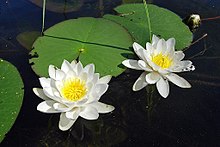Nymphaea candida
| Nymphaea candida | |
|---|---|

| |
| Scientific classification | |
| Kingdom: | Plantae |
| Clade: | Tracheophytes |
| Clade: | Angiosperms |
| Order: | Nymphaeales |
| Family: | Nymphaeaceae |
| Genus: | Nymphaea |
| Species: | N. candida
|
| Binomial name | |
| Nymphaea candida | |
Nymphaea candida J. Presl is a species of aquatic perennial herbaceous plants in the genus Nymphaea native to quiet freshwater habitats in Eurasia, it is in flower from July to August. It is sometimes treated as a subspecies of N. alba (N. alba L. subsp. candida (J. Presl) Korsh.)
Description
Nymphaea candida is an aquatic perennial herb that is laticiferous and rooted. It has a spread of approximately 60 cm and a plant depth from 10–30 cm. It has rhizomes that are stoloniferous and unbranched. There are about 10-20 leaves that are 9–19 cm across that are usually floating or submerged. The leaves are membranous when young and they are prominently veined when mature. The plant prefers growing in water-depths of about 60–80 cm. Nymphaea candida has a small white flower (10–20 cm across) with a yellow center. The flower is bisexual and it is usually floating alone. The peduncles are long and there are 4 sepals. There are about 12-24 petals on each flower. The petals can be described as oblong-ovate, apex obtuse, and white. The outer petals are shorter than the inner ones.[1]
Taxonomy
The plant was originally discovered and described by J. Presl and C Presl. in 1882. The taxonomic status of this species is unknown.[2]
Synonyms
- Castalia biradiata (Sommerauer) Hayek
- Castalia candida (C. Presl) Schinz & Thell.
- Castalia colchica Woronow ex Grossh.
- Castalia semiaperta (C. Klinggr.) Fritsch
- Leuconymphaea candida (C. Presl) Kuntze
Distribution and habitat
It grows in the quiet freshwaters in Eurasia. It only grows in water from July to August.
The plant grows only in water, as it is an aquatic plant, mainly in ponds, lakes, and slow flowing streams.[3]
References
- ^ "Nymphaea candida C. Presl". India Biodiversity Portal. Retrieved 2016-12-06.
- ^ GBIF. "Nymphaea candida C. Presl - Checklist View". www.gbif.org. Retrieved 2016-12-06.
- ^ "medicinal herbs: NYMPHAEA CANDIDA". www.naturalmedicinalherbs.net. Retrieved 2016-12-06.
